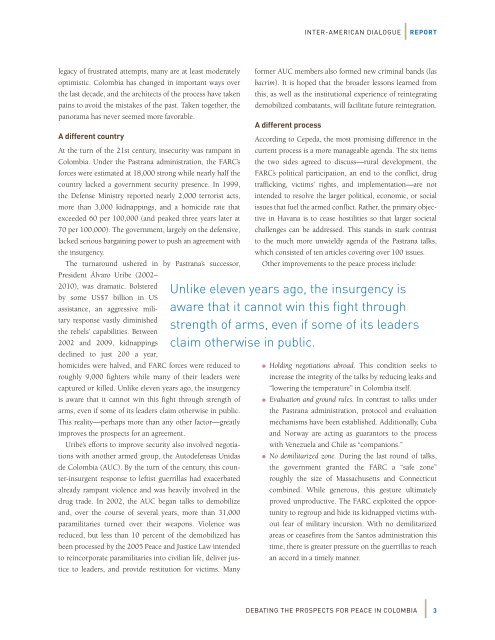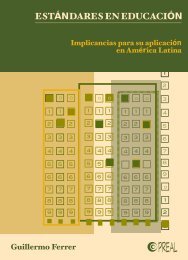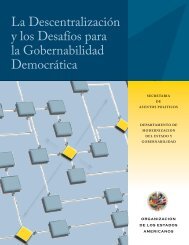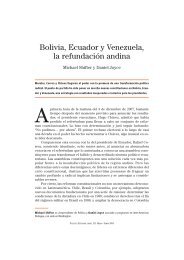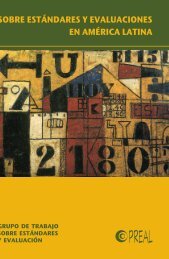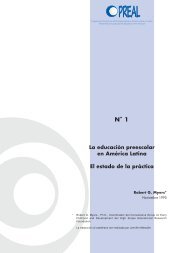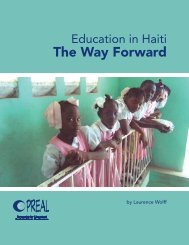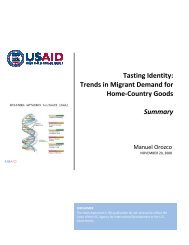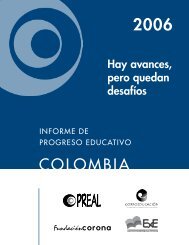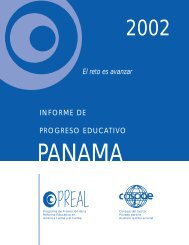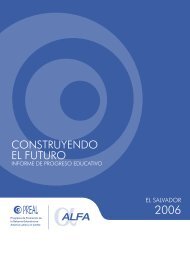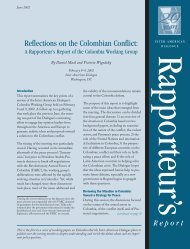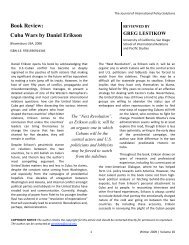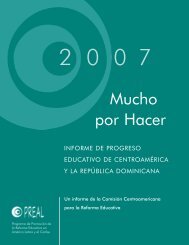Debating the Prospects For Peace in Colombia - Inter-American ...
Debating the Prospects For Peace in Colombia - Inter-American ...
Debating the Prospects For Peace in Colombia - Inter-American ...
You also want an ePaper? Increase the reach of your titles
YUMPU automatically turns print PDFs into web optimized ePapers that Google loves.
<strong>Inter</strong>-<strong>American</strong> Dialogue<br />
Report<br />
legacy of frustrated attempts, many are at least moderately<br />
optimistic. <strong>Colombia</strong> has changed <strong>in</strong> important ways over<br />
<strong>the</strong> last decade, and <strong>the</strong> architects of <strong>the</strong> process have taken<br />
pa<strong>in</strong>s to avoid <strong>the</strong> mistakes of <strong>the</strong> past. Taken toge<strong>the</strong>r, <strong>the</strong><br />
panorama has never seemed more favorable.<br />
A different country<br />
At <strong>the</strong> turn of <strong>the</strong> 21st century, <strong>in</strong>security was rampant <strong>in</strong><br />
<strong>Colombia</strong>. Under <strong>the</strong> Pastrana adm<strong>in</strong>istration, <strong>the</strong> FARC’s<br />
forces were estimated at 18,000 strong while nearly half <strong>the</strong><br />
country lacked a government security presence. In 1999,<br />
<strong>the</strong> Defense M<strong>in</strong>istry reported nearly 2,000 terrorist acts,<br />
more than 3,000 kidnapp<strong>in</strong>gs, and a homicide rate that<br />
exceeded 60 per 100,000 (and peaked three years later at<br />
70 per 100,000). The government, largely on <strong>the</strong> defensive,<br />
lacked serious barga<strong>in</strong><strong>in</strong>g power to push an agreement with<br />
<strong>the</strong> <strong>in</strong>surgency.<br />
The turnaround ushered <strong>in</strong> by Pastrana’s successor,<br />
President Álvaro Uribe (2002–<br />
2010), was dramatic. Bolstered<br />
by some US$7 billion <strong>in</strong> US<br />
assistance, an aggressive military<br />
response vastly dim<strong>in</strong>ished<br />
<strong>the</strong> rebels’ capabilities. Between<br />
2002 and 2009, kidnapp<strong>in</strong>gs<br />
decl<strong>in</strong>ed to just 200 a year,<br />
homicides were halved, and FARC forces were reduced to<br />
roughly 9,000 fighters while many of <strong>the</strong>ir leaders were<br />
captured or killed. Unlike eleven years ago, <strong>the</strong> <strong>in</strong>surgency<br />
is aware that it cannot w<strong>in</strong> this fight through strength of<br />
arms, even if some of its leaders claim o<strong>the</strong>rwise <strong>in</strong> public.<br />
This reality—perhaps more than any o<strong>the</strong>r factor—greatly<br />
improves <strong>the</strong> prospects for an agreement.<br />
Uribe’s efforts to improve security also <strong>in</strong>volved negotiations<br />
with ano<strong>the</strong>r armed group, <strong>the</strong> Autodefensas Unidas<br />
de <strong>Colombia</strong> (AUC). By <strong>the</strong> turn of <strong>the</strong> century, this counter-<strong>in</strong>surgent<br />
response to leftist guerrillas had exacerbated<br />
already rampant violence and was heavily <strong>in</strong>volved <strong>in</strong> <strong>the</strong><br />
drug trade. In 2002, <strong>the</strong> AUC began talks to demobilize<br />
and, over <strong>the</strong> course of several years, more than 31,000<br />
paramilitaries turned over <strong>the</strong>ir weapons. Violence was<br />
reduced, but less than 10 percent of <strong>the</strong> demobilized has<br />
been processed by <strong>the</strong> 2005 <strong>Peace</strong> and Justice Law <strong>in</strong>tended<br />
to re<strong>in</strong>corporate paramilitaries <strong>in</strong>to civilian life, deliver justice<br />
to leaders, and provide restitution for victims. Many<br />
former AUC members also formed new crim<strong>in</strong>al bands (las<br />
bacrim). It is hoped that <strong>the</strong> broader lessons learned from<br />
this, as well as <strong>the</strong> <strong>in</strong>stitutional experience of re<strong>in</strong>tegrat<strong>in</strong>g<br />
demobilized combatants, will facilitate future re<strong>in</strong>tegration.<br />
A different process<br />
Accord<strong>in</strong>g to Cepeda, <strong>the</strong> most promis<strong>in</strong>g difference <strong>in</strong> <strong>the</strong><br />
current process is a more manageable agenda. The six items<br />
<strong>the</strong> two sides agreed to discuss—rural development, <strong>the</strong><br />
FARC’s political participation, an end to <strong>the</strong> conflict, drug<br />
traffick<strong>in</strong>g, victims’ rights, and implementation—are not<br />
<strong>in</strong>tended to resolve <strong>the</strong> larger political, economic, or social<br />
issues that fuel <strong>the</strong> armed conflict. Ra<strong>the</strong>r, <strong>the</strong> primary objective<br />
<strong>in</strong> Havana is to cease hostilities so that larger societal<br />
challenges can be addressed. This stands <strong>in</strong> stark contrast<br />
to <strong>the</strong> much more unwieldy agenda of <strong>the</strong> Pastrana talks,<br />
which consisted of ten articles cover<strong>in</strong>g over 100 issues.<br />
O<strong>the</strong>r improvements to <strong>the</strong> peace process <strong>in</strong>clude:<br />
Unlike eleven years ago, <strong>the</strong> <strong>in</strong>surgency is<br />
aware that it cannot w<strong>in</strong> this fight through<br />
strength of arms, even if some of its leaders<br />
claim o<strong>the</strong>rwise <strong>in</strong> public.<br />
NN<br />
Hold<strong>in</strong>g negotiations abroad. This condition seeks to<br />
<strong>in</strong>crease <strong>the</strong> <strong>in</strong>tegrity of <strong>the</strong> talks by reduc<strong>in</strong>g leaks and<br />
“lower<strong>in</strong>g <strong>the</strong> temperature” <strong>in</strong> <strong>Colombia</strong> itself.<br />
NN<br />
Evaluation and ground rules. In contrast to talks under<br />
<strong>the</strong> Pastrana adm<strong>in</strong>istration, protocol and evaluation<br />
mechanisms have been established. Additionally, Cuba<br />
and Norway are act<strong>in</strong>g as guarantors to <strong>the</strong> process<br />
with Venezuela and Chile as “companions.”<br />
NN<br />
No demilitarized zone. Dur<strong>in</strong>g <strong>the</strong> last round of talks,<br />
<strong>the</strong> government granted <strong>the</strong> FARC a “safe zone”<br />
roughly <strong>the</strong> size of Massachusetts and Connecticut<br />
comb<strong>in</strong>ed. While generous, this gesture ultimately<br />
proved unproductive. The FARC exploited <strong>the</strong> opportunity<br />
to regroup and hide its kidnapped victims without<br />
fear of military <strong>in</strong>cursion. With no demilitarized<br />
areas or ceasefires from <strong>the</strong> Santos adm<strong>in</strong>istration this<br />
time, <strong>the</strong>re is greater pressure on <strong>the</strong> guerrillas to reach<br />
an accord <strong>in</strong> a timely manner.<br />
DEBATING THE PROSPECTS FOR PEACE IN COLOMBIA 3


